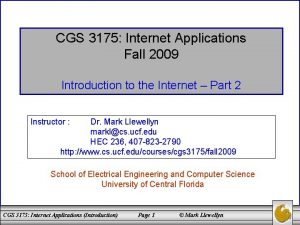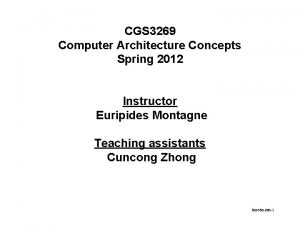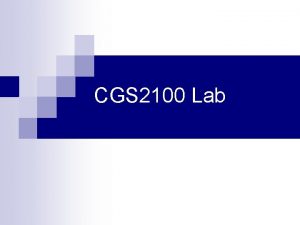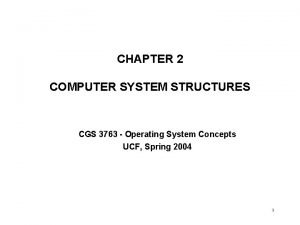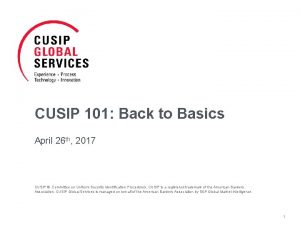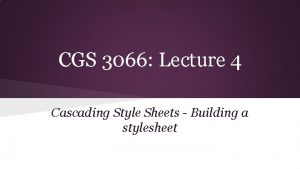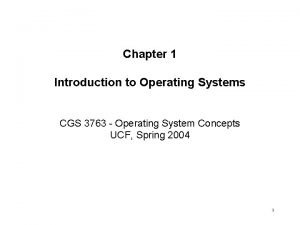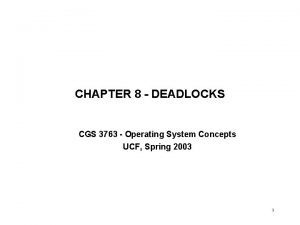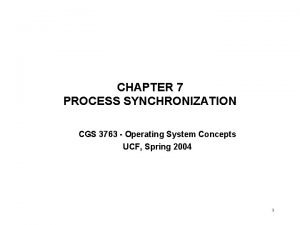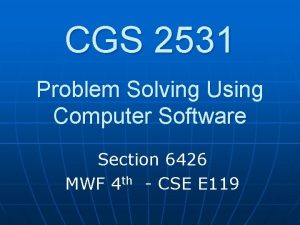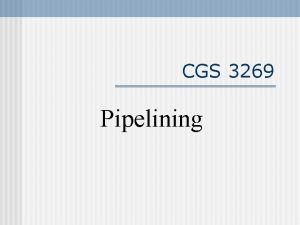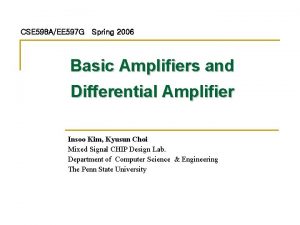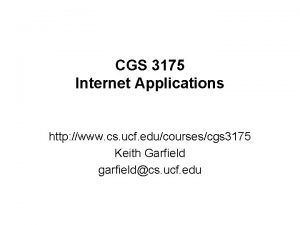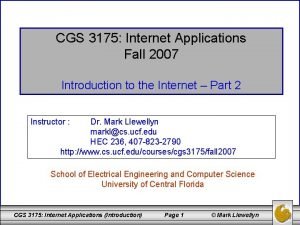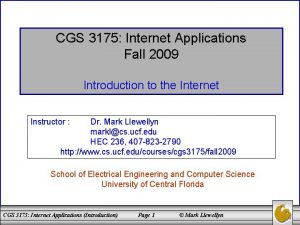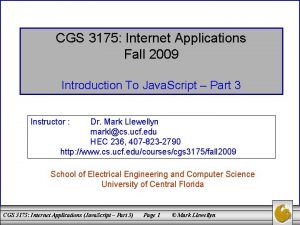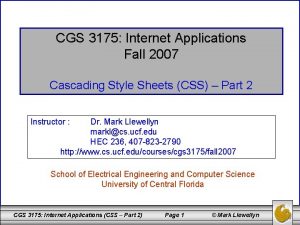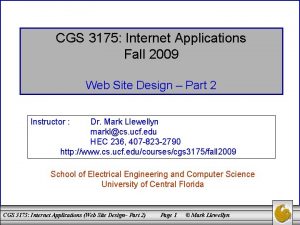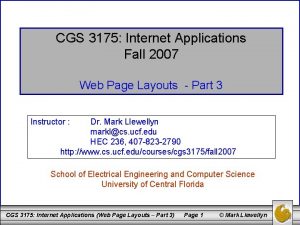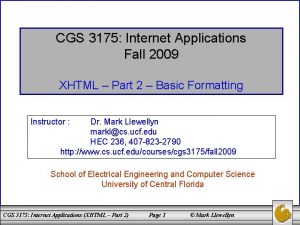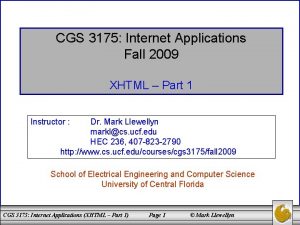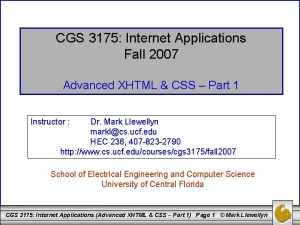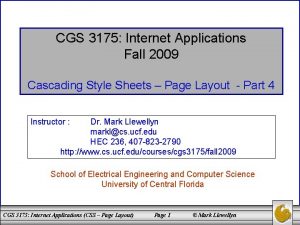CGS 3175 Internet Applications http www cs ucf














- Slides: 14

CGS 3175 Internet Applications http: //www. cs. ucf. edu/courses/cgs 3175 Keith Garfield garfield@cs. ucf. edu

Grading Policy • 500 points available throughout the semester – – – • • • Test 1 Test 2 Labs Project Final Exam A = 500 - 450 B = 449 - 400 C = 399 - 350 D = 349 - 300 Fail = 300 - 0 100 points (before drop date) 100 points 70 points 80 points 150 points

Grading Policy (cont) • Tests may only be missed via prior arrangement or with “valid excuse. ” Makeup tests will not be duplicates of in class tests. If you know ahead of time you will be missing a test, taking the test early is an option. • Standard Disclaimer: Any appearance of plagiarism or blatant copying results in a grade of zero for all parties who appear to be involved. – – Typical rules of thesis writing apply If you use a picture from another web site, credit the source If you use quotes from another source, credit it Do not cut and paste pages from commercial web sites – even if you credit them, its still plagiarism.

Grading Policy (cont) • Assignments: – The assignments have been designed to be self-pacing to a large degree. – All assignments will be posted on the course web page shortly. – All assignments are to be turned in as specified on the assignment page. – Due dates for each assignment are posted. – Due dates have been set to allow MUCH more time than the assignment allows. – Late assignments will not be accepted. Period. – Because no late assignments are allowed, turning in your assignments a week early is not only permissible, but strongly encouraged. – Assignments are worth about 15% of your grade.

Resources • Text: 2 nd Ed. Web 101 Making the ‘Net Work for You, by Wendy Lehnert • Add’l Text: Any USEFUL book on HTML (Recommend the HTML book in the O’Reilly series) • Class Web Page: http: //www. cs. ucf. edu/courses/cgs 3175 – Examples and links to other useful pages.

Course Topics • Internet Basics: What it is and what it isn’t. What’s going on when you use your browser? • Familiarization with basic applications: Email, Searching, Browsing, File Transfers • Net safety and net etiquette: Online communities, flame wars, viruses and hoaxes. • Web site design and construction: Why are so many web sites so bad? What makes them good? • Using the Net: Accessing remote computers. • What does it all mean? Who cares?

Internet Basics • A computer network is what you get when you connect computers. • An internet is what you get when you connect networks.

Internet Origins (1/3) • Late 1970’s: Local Area Networks (LANs) beginning to be common. – Colleges, military, businesses. – Smaller powerful machines introduced. – LANs were incompatible, and separate. • Late 1970’s: Wide Area Network technology exists. – Incompatible with LANs. • ARPA had conducted network experiments in the 1960’s. – Project and prototype system were known as internet.

Internet Origins (2/3) • 1970’s: Internet Standards Published: – Internet Protocol (IP) for basic communication. – Transfer Control Protocol (TCP) for more secure, efficient communication. – TCP/IP is still the basis for “lossless” internet communication. – Gov’t required that new standards be publicly available (open), which went against all business models. – TCP/IP incorporated into UNIX operating system. • 1980’s: military adopts TCP/IP to unify their networks (ARPANET backbone). • 1980’s: Explosive growth – NSF wanted every university CS department connected (NSFNET backbone). – Grad students “volunteer” their time. – Internet Activities Board (IAB) evolves. – Internet quadruples in size in 2 years.

Internet Origins (3/3) • 1990’s: Big business is recruited to extend the internet – IBM, MERIT, and MCI form Advanced Networks and Services (ANS) – ANS backbone develops. – By 1999, adding one computer per second. – By 2006, adding 10 computers per second.

Internet Origins (Summary) • 1966 ARPA Experiments • • • • 1969 1972 1980 1986 1990 1992 1994 1995 1996 1997 2000 2002 2005 1 ST ARPA Nodes Email Invented TCP Experiments NSF-net Backbone ARPANET Retired Mosaic Introduced 0 People Online 0. 2 M Online 0. 7 M Online 2. 1 M Online 5. 0 M Online 9. 5 M Online 16 M Online 73 M Online 147 M Online 318 M Online

Internet Basics • The modern internet had two driving forces behind it – The military: Command Control of forces – Acadamia: Sharing research data • This history helped shape today’s internet – Military legacy: No central organization as a single point of control is vulnerable to attack. – Academic legacy: The basic internet structures were designed to transport data and distribute resources as opposed to the commercial applications dominating the internet today.

Internet Characteristics • The internet is LARGE: – How many millions of web sites world wide? • The internet is a DISORGANIZED: – Heterarchical structure as opposed to hierarchical structure • The internet is DYNAMIC: – Large numbers of web sites come and go. – Even “stable” web sites change content constantly.

How the Internet Looks to You CHAOS
